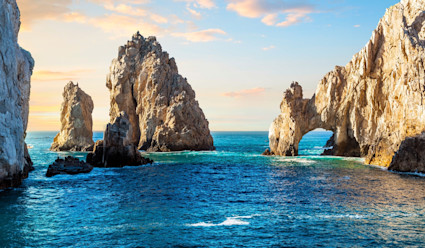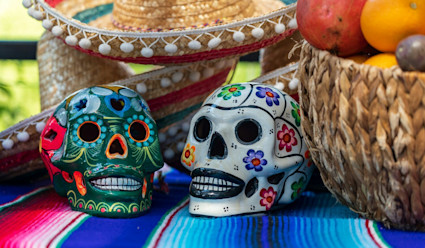
What is Dia de los Muertos
Día de los Muertos, or Day of the Dead, is one of the most meaningful Mexican holidays and beloved cultural celebrations. Rooted in ancient Aztec beliefs and Catholic traditions, it’s a joyful time to remember and honor those who have passed away. Families create colorful ofrendas (altars) decorated with marigolds, candles, and favorite foods of the departed, symbolizing the connection between life and death. Rather than mourning, the holiday celebrates love, memory, and the continuity of spirit — a reflection of Mexico’s deep respect for family and heritage.Dia de los Muertos traditions
What sets Dia de los Muertos apart from other Mexican holidays are the unique traditions, symbols, and celebrations that accompany it. Here’s what you can expect to see and experience:Symbols & decorations
Bright orange marigolds, or cempasúchil, are scattered throughout homes, plazas, and altars to guide spirits back to the living world. Sugar skulls and elegantly dressed Catrinas celebrate the individuality of each departed soul, while delicate papel picado banners flutter overhead, adding movement and color to the streets. Together, these symbols create a playful yet meaningful visual experience that captures the joy and reverence of the holiday.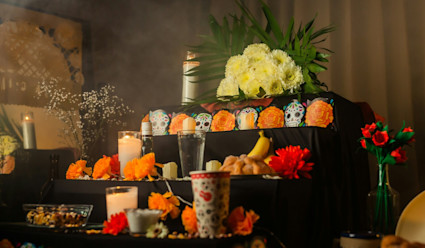
Altars (Ofrendas)
Central to the celebrations, altars — or ofrendas — are lovingly assembled with photos, candles, flowers, and the favorite foods and drinks of deceased loved ones. Each element carries deep significance: candles illuminate the path for returning spirits, marigolds mark their way, and offerings welcome them back for a night of remembrance.Food & drink
Food is at the heart of most Mexican celebrations, and Día de los Muertos is no exception. Families and chefs alike prepare traditional treats such as pan de muerto, a soft, sweet bread decorated with bone-shaped designs, and tamales, which can be savory or sweet. Warm drinks like atole, a sweet corn-based beverage symbolizing the connection between the living and the deceased, and Mexican hot chocolate complement these dishes, creating a comforting and festive atmosphere. Día de los Muertos is as much a culinary celebration as it is a cultural one, with every bite carrying meaning and tradition.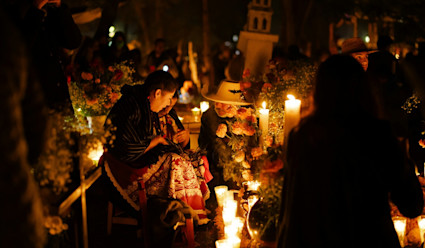
Cemeteries & remembrance
Visiting and decorating graves is a time-honored practice during Día de los Muertos. Families carefully clean headstones, place marigolds and candles, and bring mementos to honor their loved ones. In many cases, these gatherings extend late into the night with music, food, and storytelling, turning mourning into a joyful reflection of life.Festivities & community celebrations
Locals and visitors alike join in the spirited dance of tradition and modern celebration, often dressed as Catrinas and moving to upbeat mariachi rhythms. From bustling public events to serene, intimate dinners, the holiday captures the essence of Mexico’s most beloved cultural celebration, with every street, plaza, and gathering filled with color, music, and the joyful remembrance of loved ones.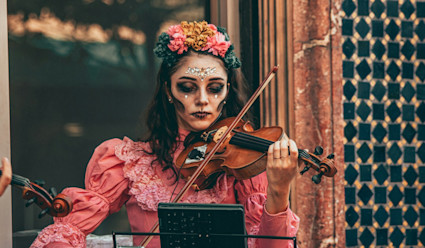
Where to celebrate Día de los Muertos in Los Cabos
You won’t have to spend much time wondering where to celebrate Día de los Muertos in Los Cabos. Streets across the region fill with parades, live music, art exhibitions, and face painting. Here are some of the best ways to experience authentic Mexican celebrations.San José del Cabo Art Walk & altar displays
The historic downtown of San José del Cabo hosts an annual Art Walk that beautifully intertwines with Día de los Muertos. Streets in the gallery district are lined with handmade ofrendas, local art, and live music, while galleries open their doors for special exhibits honoring Mexican heritage. As evening falls, the neighborhood glows with marigolds and candlelight, and costumed performers bring the celebration to life.Cabo San Lucas marina celebration
If you’re wondering where to celebrate Dia de los Muertos with a fun and festive energy, head to the marina. The marina transforms into a waterfront festival filled with music, traditional food stands, and vibrant decorations. You’ll find locals and visitors alike enjoying Catrina face painting, live entertainment, and candlelit altars overlooking the sea — a beautiful way to experience the spirit of the holiday against the backdrop of Cabo’s coastline.Flora Farms Día de los Muertos dinner & altars contest
For an upscale experience, head to Flora Farms, which hosts a themed dinner each year featuring regional dishes, handcrafted cocktails, and stunning altar displays. The farm’s annual altars contest showcases incredible creativity from local artists and families, making it one of the most memorable ways to honor the occasion.Hotel & resort festivities
Many of Los Cabo’s luxury resorts, including The Cape, Waldorf Astoria Los Cabos Pedregal, and Esperanza, celebrate with elegant dinners and cultural programming. Expect beautifully designed altars, live mariachi music, and traditional treats like pan de muerto and tamales. Guests can often join in with Catrina makeup stations or guided activities that share the meaning behind each symbol of the holiday.Community events & cultural gatherings
Across Los Cabos, plazas and cultural centers host lively community celebrations filled with music, dance, and food. In San José del Cabo’s Plaza Mijares, families come together to build altars, share stories, and honor their loved ones. Some locals also visit nearby cemeteries, decorating graves with marigolds and candles that burn well into the night — a deeply moving expression of remembrance and perhaps the most meaningful of the Mexican holidays.